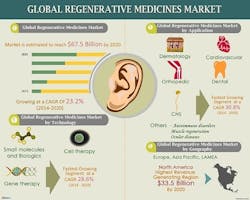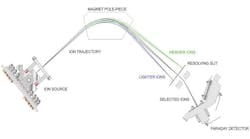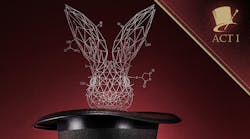Regenerative medicines have the ability to restore the lost functionality of tissues or organs—unlike conventional medicines, which are palliative. The huge potential of these medicines in repairing or regenerating diseased organs is a major reason there’s an intensive focus on research and development in this field. According to a new market research report "Global Regenerative Medicine Market (Technology, Applications, Geography) - Industry Analysis, Trends, Opportunities and Forecast, 2013-2020," the global regenerative medicine market will reach $67.6 billion by 2020. That’s quite a jump from $16.4 billion in 2013, say Allied Market Research (AMR) analysts, noting that to achieve that growth a CAGR of 23.2 percent is forecast during a six-year period (2014 - 2020).
The technologies implemented for these medicines utilize various cell types including stem cells, say AMR analysts, and that advancements in nanotechnology and stem cells application will likely frame further progress in this novel and growing field of therapy development.
Based on the different technologies, the global regenerative medicine market is segmented into biologics, gene therapy, cell therapy and small molecules. Presently, biologics are extensively used for producing regenerative medicines followed by cell therapy. Cell therapy technology includes stem cell based methods for treating various disorders. However, most of the gene therapy products are still in clinical trials. The global market for biologics and small molecules is the largest revenue-generating segment, notes the report, which is estimated to be $9.0 billion in 2013. However, gene therapy technology is expected to lead the segment at a CAGR of 28.6 percent during 2014-2020. The reason for this rapid growth say AMR analysts, lies in the ability of gene therapies to reduce immune reactions post transplantation.
Regenerative medicine applications include dermatology, cardiovascular, central nervous system (CNS), orthopedic & dental and others. Companies developing dermatology, cardiovascular and orthopedic applications have commercialized regenerative products and are pursuing ongoing clinical trials. Additionally, says the report, numerous clinical trials are in process for CNS disorders. However, CNS applications are expected to be the most attractive segment, at a CAGR of 30.8 percent over the next six years.
Geographically, the market study encompasses North America, Europe, Asia-Pacific and LAMEA. North America and Europe together accounted for over 3/4th of the market revenue in 2013 say AMR analysts, and not surprisingly is projected to be most lucrative regional market. However, technological adoption and emphasis on research of these medicines is accelerating in Japan and South Korea. This may lead to a substantial contribution to the field of regenerative medicines from these countries during the forecast period says the report, with Asia-Pacific leading as the fastest growing regenerative medicine market in the region.
The report expands on the strategies fostered by the prominent players in the market, According to AMR of those surveyed, including Shire pharmaceuticals, Advanced Cell Technology, Genzyme, Athersys Inc., Kinetic Concepts, Inc., NuVasive, Stem Cells, Inc., Cytori Therapeutics, Inc., Cytomedix, Inc. and Mesoblast Ltd., those companies have adopted approval as their primary strategy.
Access the detailed report with TOC






